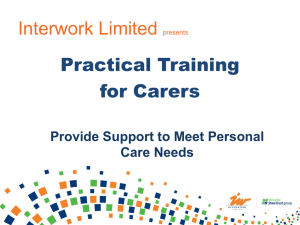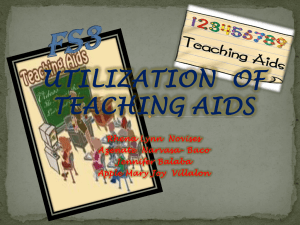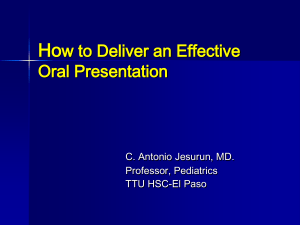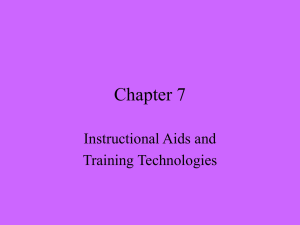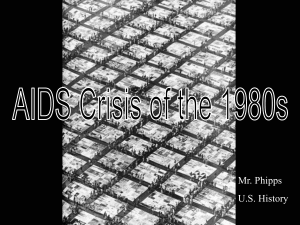Cross-country-comparison-of-domestic-AIDS
advertisement
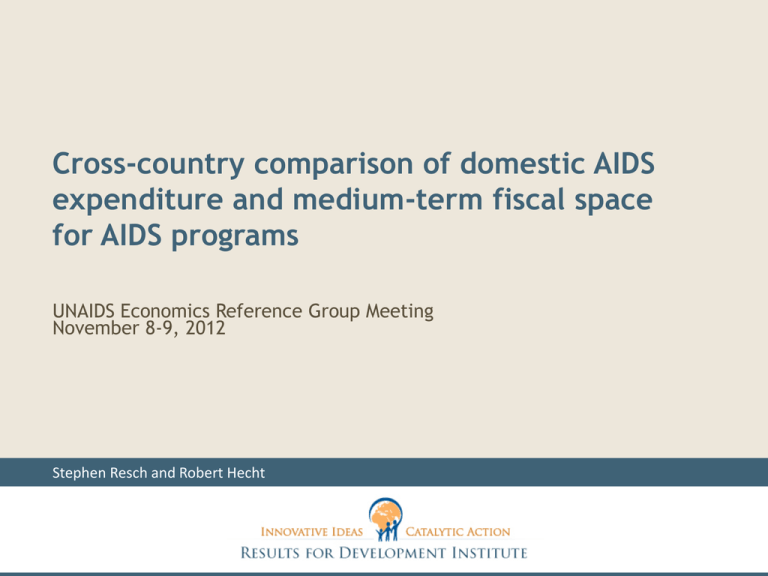
Cross-country comparison of domestic AIDS expenditure and medium-term fiscal space for AIDS programs UNAIDS Economics Reference Group Meeting November 8-9, 2012 Stephen Resch and Robert Hecht Objective What proportion of AIDS spending is coming from domestic versus external sources? How much more of the financial burden of AIDS programs could countries reasonably shoulder themselves? With maximum domestic effort to support AIDS programs, what level of external resources would still be required from external sources such as PEPFAR, Global Fund, etc to meet the overall needs to operate an effective national AIDS program? How can we monitor implementation of Partnership Frameworks agreements? Main findings 1. Room for domestic AIDS spending to double or triple in medium term 2. Major work needed to strengthen financial information NEEDS ESTIMATION National strategic planning with credible resource needs estimates EXPENDITURE TRACKING Development and routine financial tracking to monitor PEPFAR Partnership Framework agreements Need to improve turnaround time, completeness, comparability of ad hoc expenditure analysis (e.g. NASA, NHA) 3. More work needed to explain variation between countries in resource estimates and AIDS spending per person living with HIV/AIDS (PLWHA) Scope of study Twelve original PEPFAR focus countries (Over 50% of global AIDS burden) Botswana Cote d’Ivoire Ethiopia Kenya Mozambique Namibia Nigeria South Africa Rwanda Tanzania Uganda Zambia (1) a retrospective review of AIDS program financing, comparing countries to one another and to selected benchmarks (2) a forward-looking analysis assessment of the potential for increasing domestic financing of AIDS programs $0 $9 $12 $28 $29 $30 $37 Tanzania 2008/09 Domestic AIDS financing Amount(millions) 400 $0 $4 $36 $20 $9 $24 $30 $9 $30 Domestic AIDS financing per PLWHA South Africa $800 Botswana $96 $98 $200 Kenya $600 Namibia $229 Uganda 800 Nigeria 000 Zambia Total (millions) Ethiopia $1,153 $1,000 Tanzania 200 Côte d'Ivoire $1,200 Rwanda 400 Mozambique South Africa 2009/10 Botswana 2008 Kenya 2008/09 200 Namibia 2008/09 Uganda 2008 Nigeria 2008 Zambia 2006 Ethiopia 2008 $6 Côte d'Ivoire 2009 $5 Rwanda 2008 Mozambique 2008 Domestic AIDS Expenditure Per PLWHA $715 $532 600 $400 $206 $65 Evaluating domestic effort and assessing the potential for ‘fair’ increase in domestic financing of AIDS programs Normative benchmarks 1. Abuja Target for Government Health Expenditure (and proportional increase in AIDS spending) 2. AIDS Share of Health Spending in proportion to disease burden share (measured in DALYs) FOUR IMPORTANT CAVEATS: Government health expenditure (GHE) is not a clean measure of domestically-sourced funding [Domestic Share of GHE ~70% (40-110%)] Opportunity cost of increased AIDS spending / Cost-effectiveness Consideration of downstream savings Disease burden share may decline with ART scale up, while resource need remains Variation in government health spending levels Variation in the size of resource bucket from which AIDS programs are domestically financed UMI LI-LMI 18.0% 15.0% 12.0% 9.0% 6.0% 3.0% 0.0% 18% 15% 12% 9% 6% 3% 0% Abuja Abuja target: GHE/GGE = 15% • Issue: GHE Public Funds for Health (PFH), GHE doesn’t exclude ‘on-budget’ donor aid** GHE per capita varies 5-fold among current LICs • Botswana GHEpc is 2.5 times other 2 UMICs Which bucket of money is the appropriate reference point for evaluating domestic effort Countries vary widely in the share of national resources flowing into downstream public resource buckets. AIDS spending lies primarily in the health sector and could be bound by GHE level At what level of government are AIDS resource allocations determined? What does it say about a country’s AIDS financing effort if a health ministry allocates a relatively large portion of the health budget to AIDS, but this level of GAE is low relative to GDP, because the health budget is relatively small? GDP GGE (17-48% GDP) GHE (5-18% GGE) GAE (1-26% GHE) Variation in government AIDS expenditure (GAE) as a share of health spending …compared to AIDS’ share of disease burden 100% Countries fall into 3 groups: 80% 60% 40% Kenya, Uganda & Ethiopia (70-90%) Namibia, Botswana, Zambia, South Africa, and Cote d’ Ivoire (29-54%) Nigeria, Tanzania, Mozambique, Rwanda (5-12%) 20% DALY Share Spending to – Burden Spending–Fraction as %Ratio of DALY Share Rwanda Mozambique Tanzania Nigeria South Africa Zambia Botswana Namibia Côte d'Ivoire GAE/GHE Ethiopia Uganda Kenya 0% Summary Indicators of Domestic Priority for AIDS Comparison of DIPI measures 1.00 0.90 0.80 0.70 0.60 0.50 0.40 0.30 0.20 0.10 0.00 0.12 0.08 0.06 0.04 0.02 UNAIDS DIPI Health Exp-based 'DIPI' Botswana Uganda Namibia Ethiopia Zambia Kenya Rwanda South Africa Côte d'Ivoire Tanzania Nigeria 0.00 UNAIDS DIPI 0.10 Mozambique Health Expenditure-based DIPI UNAIDS DALY DIPI and Health Expenditure-based DIPI Potential for increase fiscal space for AIDS Three scenarios for increasing domestic GAE Countries fell into 3 groups… Domestic AIDS spending per PLWHA Abuja target already met, All opportunity in DALY share only $90 Mozambique DALY share target nearly met, All opportunity in Abuja only $250 Kenya $80 $200 $70 $60 $150 $50 $40 $100 $30 $20 $50 $10 $0 $0 Actual Abuja DALY Abuja & Share DALY Similar countries: ZAM, TZA, RWA, NAM, BWA Actual Abuja DALY Abuja Share & DALY Similar countries: UGN Opportunity for both meeting Abuja and DALY share targets $200 $180 $160 $140 $120 $100 $80 $60 $40 $20 $0 Côte d'Ivoire Actual Abuja DALY Abuja & Share DALY Similar countries: ZAF, NGA, ETH Actual = Status Quo, Abuja = (GHE/GGE=15%), DALY Share = GAE/GHE proportional to AIDS DALY share, Abuja & DALY = Maximal domestic contribution Resource needs estimates $1,800 $1,600 $1,400 $1,200 $1,000 $800 $600 $400 $200 $0 Difficult to assess the reasonableness of this variation Not simply explained by input price levels (GNI proxy) Mozambique Tanzania Rwanda Nigeria Uganda Ethiopia Côte d'Ivoire Kenya Zambia Namibia South Africa Botswana Amount Needed per PLWHA NSP estimates, adjusted for epidemic size, vary much more than UNAIDS Investment Framework model NSP per PLWHA (2011) UNAIDS IF per PLWHA (2011) Partly explained by the scale or mix of planned activities? Inaccurate estimation or ‘gaming’? Scenarios for Increasing Domestic Effort: Annualized Amounts for 2012-16. UNAIDS: $7.4 B NEEDED Scenario Government AIDS Expenditure NSP: $9.5 B NEEDED DOMESTIC SHARE GAP REQUIRING EXTERNAL SUPPORT DOMESTIC SHARE GAP REQUIRING EXTERNAL SUPPORT 1. GROWTH $2 B 27% $5.4 21% $7.5 2. ABUJA $3 B 41% $4.4 32% $6.5 3. DALY $4.4 B 59% $3.0 46% $5.1 4. MAX (2+3) $5.2 B 70% $2.2 55% $4.3 Share of AIDS program cost covered with ‘maximum domestic effort’ (Abuja + DALY Share) 100% 90% 80% 70% 60% 50% 40% 30% 20% 10% 0% Econ Growth only Max Additional Biggest relative increase Main findings 1. Room for domestic AIDS spending to double or triple in medium term, but need for donor support will remain 2. Major work needed to strengthen financial information RESOURCE NEEDS ESTIMATION ROUTINE EXPENDITURE TRACKING 3. More work needed to explain variation between countries in resource estimates and AIDS spending per person living with HIV/AIDS (PLWHA) THANK YOU Stephen Resch stephen_resch@harvard.edu Center for Health Decision Science Harvard School of Public Health Robert Hecht rhecht@resultsfordevelopment.org Results for Development Institute and the R4D Team: Richard Skolnik, Toby Kasper, Theresa Ryckman, Gabrielle Partridge, Kira Thorien
